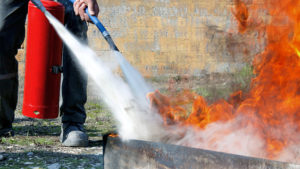
Invest the time in training to correctly use a fire extinguisher.
Fire extinguishers can be an effective tool, but only when you select the correct type for your needs; install them in the most effective locations; and learn the proper way to use them. This three-part series covers the basics of fire extinguishers.
Part 3 of 3 –
Once activated, a fire extinguisher typically provides less than 30 seconds of use. That’s why proper training and application are critical to ensuring effectiveness.
Whether in your home or place of business, your first action when a fire occurs should be notification:
- Call the local fire department
- Activate the alarm system
- Ensure that everyone begins evacuating the building
If the fire is still in the early stages, consider using a fire extinguisher. Before attempting to suppress the fire, be sure to verify that you have a safe evacuation route out of the building and that the smoke and heat are not too great to keep you from getting to safety.
Remember the acronym PASS when using the extinguisher:
- P – Pull the Pin
- A – Aim the extinguisher at the base of the fire
- S – Squeeze the release handle to activate the extinguisher
- S – Sweep from side to side until the fire appears to be out
If the fire continues to grow, evacuate the building and allow the fire department to suppress the fire.
Remember: If you have any doubt, GET OUT!
According to the Occupational Safety and Health Administration, employees should be familiar the general principles of a fire extinguisher and the hazards involved. Many local fire departments offer hands-on training and training aids to local businesses. Reach out to your local fire department and see how they can assist your training needs. More information on fire extinguisher use is available from the Occupational Safety and Health Administration.
Part 1: Select the correct fire extinguisher for your needs
Part 2: Correctly place fire extinguishers for optimum use
This loss control information is advisory only. The author assumes no responsibility for management or control of loss control activities. Not all exposures are identified in this article.
